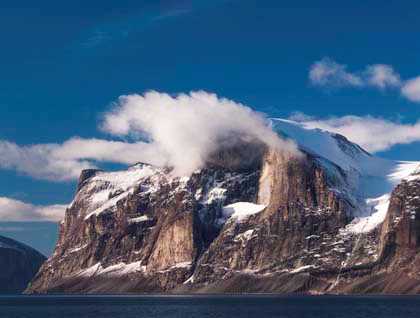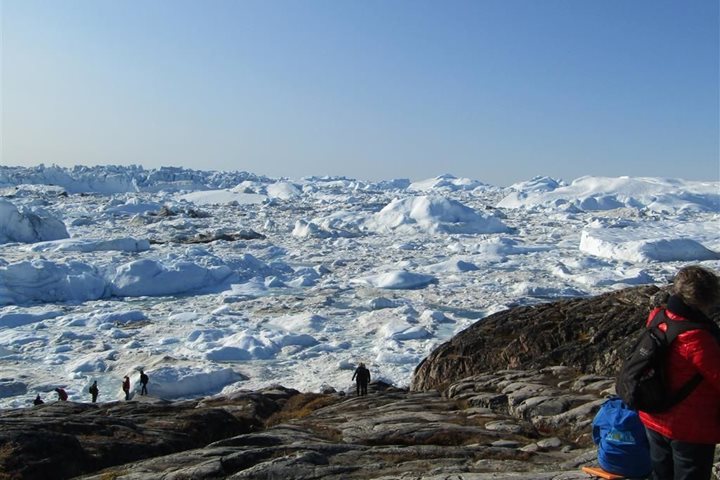Our morning was spent cruising around the complex fjord system that empties into Buchan Gulf. This operation took us into three interconnected fjords while providing us with truly spectacular scenery as we searched for wildlife. The bright sunshine made for wonderful photographic opportunities of the surrounding gneissic mountains, numerous tidewater and hanging glaciers, and reflections on the water.
We eventually ended up in Icy Arm, where we found our main quarry … narwhals! There were several small groups of them scattered about in open, deep water, as well as in shallow water along shorelines. It was very hard to photograph them, because of their small size (about 12 to 15 feet or 4 or 5 meters) and quick rolling breaths at the surface made it difficult to focus a camera on them fast enough for a good photo (hence no decent photograph to go along with this report). A few of us think we saw at least one male show his unicorn-like tusk. Some of us observed an interesting phenomenon as individual narwhals swam through the milky river runoff areas near glacial meltwater rivers … we could actually follow their track lines as they stirred clear water from below up through the thin layer of milky surface fresh water. Narwhals are very much at home in deep water found within these fjords, being able to comfortably dive to more than 1,000 meters, but they appeared to be equally happy to inhabit very shallow waters of the glacial river deltas.
Right after lunch we landed at Fecham Bay, near the head of Icy Arm. The equable weather and climatic conditions encountered ashore made it difficult to accept that we were really in the high Arctic environment of northeastern Baffin Island. Our landing site is located well north of the Arctic Circle at 71º 48.9' N, 074º 31.5' W. A short distance from the landing, we encountered the wreckage of an old canvas-covered wood frame boat and an abandoned supply depot consisting of a bunch of very rusty 55-gallon drums, as well as several ancient Thule semi-subterranean winter home sites (minus the roofs made from whale bones covered with animal skins), perhaps dating back many hundreds of years.
The surrounding Arctic tundra provided some weird hiking at times through dense, spongy, thick moss carpets, boggy slurping within meltwater runoff, and careful stepping through areas of rocks and boulders as many of us made our way to the higher plateaus or ancient terraces. This valley contains huge glacial moraines laid out in several directions. It is hard to imagine the immense rivers of ice necessary to have done this. And, we could look down on the raging meltwater river that washes out the finely crushed rock material that has formed the beach where we landed. As expected, we were rewarded with magnificent views from atop the terraces.
In the meantime, back at the landing beach, our galley staff set up a beach barbeque where we could enjoy polish sausage hot dogs and various drinks upon our return. It was a very nice touch, and was especially appreciated by the energy-expended hikers. Everyone enjoyed the nice mild temperature and sunny conditions at the barbeque site, but it was amazing how quickly people became ready to return to the ship when the sun sank behind the mountain and put us in cooling shadows.







